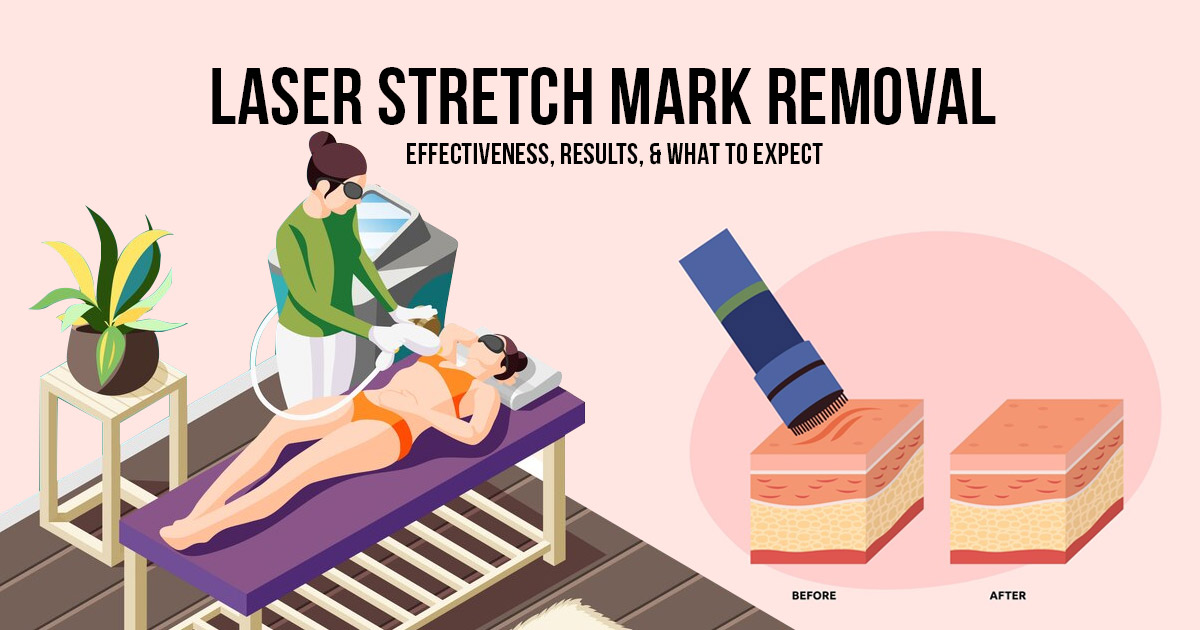Laser Stretch Mark Removal: Effectiveness, Results, & What to Expect

Stretch marks are common and can show up on your belly, thighs, arms, or back. They often appear after pregnancy, sudden weight changes, or growth spurts. Research indicates that up to 80% of people will develop stretch marks at some point in their lives, making it a widespread concern. Stretch marks are not dangerous, but they can cause self-consciousness. If creams and lotions haven’t worked for you, laser stretch mark treatment might be an option to consider. However, is laser stretch mark removal effective?
What is Laser Stretch Mark Treatment?
Using concentrated light, laser treatment for stretch marks improves the appearance and healing of your skin. The process works by boosting collagen and elastin in your skin—two materials that keep it firm and flexible. Moreover, lasers target scar tissue, which gradually lessens the visibility of stretch marks.
This treatment uses a variety of laser types, such as:
- Ablative lasers, which remove the outer layer of skin, allow smoother skin to grow.
- Non-ablative lasers, which go deeper into the skin without affecting the surface. These help new collagen grow gradually.
- Pulsed dye lasers (PDL), often used for red or purple marks, focus on the skin’s blood vessels.
- Fractional lasers, which create small zones in the skin for targeted treatment, work well on older or wider marks.
Your dermatologist will select the best course of action based on the severity of your stretch marks and your skin type.
Does Laser Stretch Mark Removal Work?
Yes, in a nutshell, but it depends on things like how old your stretch marks are and what color they are. Newer stretch marks that are red or purple usually respond best to laser treatment because the skin is still repairing itself. These marks can fade significantly over several sessions.
Results may be less dramatic for older silver or white stretch marks. Although lasers can enhance their texture and reduce their visibility, they might not entirely vanish. Studies show improvement rates ranging from 20% to 60%, so the results can vary from person to person.
What Happens During Laser Treatment?
If you’re wondering, “does laser stretch mark removal hurt?” the answer is that it’s usually not very painful. The majority of people report that it feels slightly warm or like a sudden snapping sensation on their skin. In order to make you more comfortable, your doctor will probably apply a numbing cream before beginning.
Depending on how large the area is, the actual treatment takes anywhere from 30 to 90 minutes. Your stretch marks are directly treated with lasers to target the deeper skin layers. Similar to a mild sunburn, you may experience some redness or swelling after the session. These effects typically disappear within a few days, so do not worry.
Several sessions will be necessary to achieve the best outcomes. Most people require around four to six treatments, spaced a few weeks apart, although severe cases might need more.
Laser Stretch Mark Removal Results
Many people who undergo treatment share positive laser stretch mark removal reviews, saying their skin looks smoother and the marks are harder to notice. For example, someone with recent pregnancy stretch marks may see significant fading in the red or purple streaks after just a few sessions.
However, remember that no two people respond to laser treatment in the same way. Older marks are harder to treat, and results can vary depending on your skin type and how your body reacts to the laser.
Another common question is, “does laser get rid of stretch marks permanently?” Unfortunately, the results aren’t permanent. While the treatment can make stretch marks much less noticeable, new ones can form if your skin stretches again, such as during another pregnancy or weight gain.
Is Laser Stretch Mark Treatment Right for You?
Not everyone can benefit from laser therapy. After treatment, people with darker skin tones may notice changes in their pigmentation. Stretch marks that are white or very old may not fade as much, making them harder to treat.
This treatment should be avoided by those who are pregnant, nursing, have certain medical conditions, or have skin infections. Always consult a dermatologist first to see if laser therapy is a good match for your situation.
Your Journey to Smoother Skin
Taking care of your skin after laser stretch mark treatment is key to maintaining those great results. Protect treated areas by avoiding direct sunlight or always applying sunscreen. Using moisturizers enriched with vitamin E or collagen can keep your skin hydrated, smooth, and healthy-looking.
Also, keep in mind that if your skin is stretched significantly again, stretch marks may reappear. The benefits of laser therapy can be extended by keeping your weight steady and taking care of your skin.
While laser treatments might not completely erase stretch marks, they can transform their appearance, helping you feel more at ease in your own skin. Speaking with a skilled dermatologist can provide you with answers and a plan tailored to your needs if you are unsure if it is the right decision for you. With the right approach and proper care, your path to smoother, more confident skin can be closer than you think!
